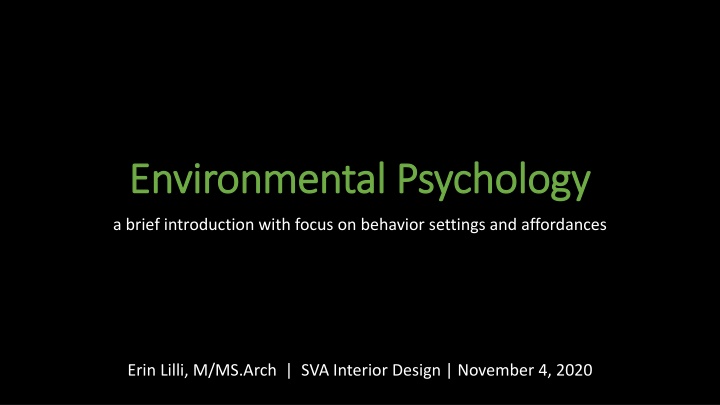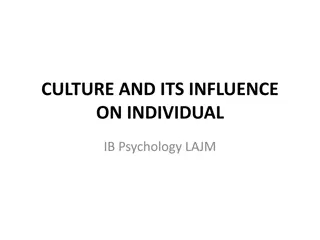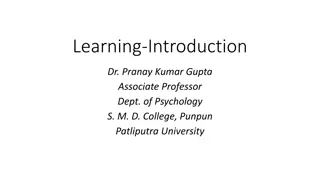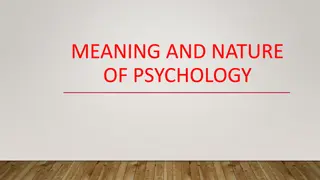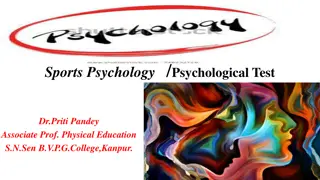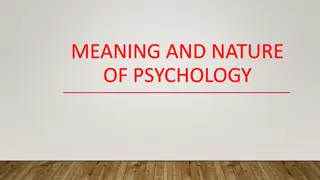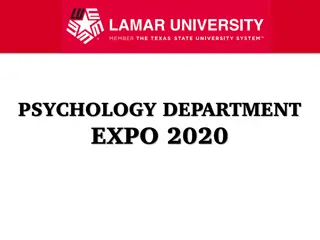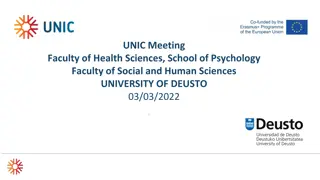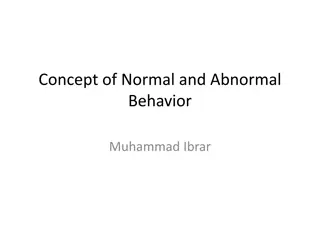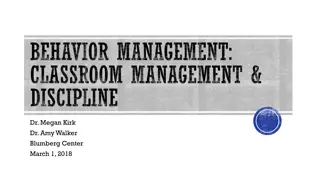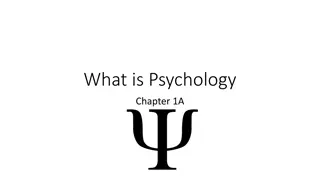Overview of Environmental Psychology: Behavior Settings and Affordances
Environmental Psychology (EP) explores how environments influence human behavior, attitudes, and identities, emphasizing the transactional relationship between individuals and their surroundings. This interdisciplinary field rejects dualistic views and focuses on experiential learning within physical, natural, and social settings. Influenced by John Dewey's pragmatism, EP emphasizes problem-solving and collective knowledge building. EP uses diverse research methods to study the impact of environments on people and vice versa.
Download Presentation

Please find below an Image/Link to download the presentation.
The content on the website is provided AS IS for your information and personal use only. It may not be sold, licensed, or shared on other websites without obtaining consent from the author.If you encounter any issues during the download, it is possible that the publisher has removed the file from their server.
You are allowed to download the files provided on this website for personal or commercial use, subject to the condition that they are used lawfully. All files are the property of their respective owners.
The content on the website is provided AS IS for your information and personal use only. It may not be sold, licensed, or shared on other websites without obtaining consent from the author.
E N D
Presentation Transcript
Environmental Psychology Environmental Psychology a brief introduction with focus on behavior settings and affordances Erin Lilli, M/MS.Arch | SVA Interior Design | November 4, 2020
Lecture Format 1. Theoretical Foundations of Environmental Psychology 25-30 mins 2. EP at The Graduate Center 3. Research Methods 4. Behavior Settings & Affordances 5. Conduct a mini-study 15 minutes 6. Share & Discuss 15 minutes Source: https://thecityfix.com/
Theoretical Foundations of Environmental Psychology? Transactional relationship between humans and their environment The study of how our environments shape our behaviors, feelings, attitudes, identities and, in turn, how people shape their environments Environment can be physical/built, natural, or social settings EP is problem- and values- oriented and situates itself in the messiness of the real world. EP privileges the situatedness of a person within social-, political, and economic- contexts and how we develop knowledge built off sequences of experience within these contexts. IOW what is reality is what is had by habit and experience, it doesn t exist prior to or outside our experiences of it EP is a highly interdisciplinary field utilizing a variety of methods from surveys to ethnography EP recognized a multitude of ways of researching and acquiring knowledge Philosophically, EP rejects a dualism of the mind and body, meaning our understanding of the world isn t contingent upon finding pre-existing, objective truths regarding human-environment relations, but rather learning through experiencing our environment
Dewey & the Transactional Roots of Environmental Psychology? EP as a discipline was strongly influenced by the thinking of John Dewey, partly as he sought to center the utility of social sciences for collective problem solving (as opposed to using it for intelligence tests) Dewey was an Empirical Naturalist meaning he considered nothing in metaphysics to be unnatural or unempirical o Believes our experiences are not outside nature, but a part of it o As a non-rationalist, does not believe there are innate structures to which we make sense of rather they are had through experiencing (habits, thinking, the self) John Dewey, 1859 1952 | American philosopher, psychologist, education reformer | most associated with Pragmatism and advocation for democracy
Transactional Roots of Environmental Psychology? Immediate Empiricism things are as they are experienced and that is real to you (e.g. the sound is frightening if I am frightened by it) Na ve Realism when you later gain knowledge by further examining what the sound was from (a gunshot or something dropping). But your initial fear, although it may be false/misplaced if proven the sound was from a benign source, is no less real. Physical properties of things are just one kind among many other properties such as moral, social, aesthetic the realness of something is how it lends itself to methods for revealing its properties Dewey traced a history of human environment relations to explain his transactional approach Greeks: self action, objects move in accordance with inner nature Scientists: observe how nature unfolds, but humans are separate from it Galileo/Newton: experimentation, scientist interacts with nature, but still separate from it (there is ultimate reality outside us)
Transactional Roots of Environmental Psychology? Dewey s Critique of the Reflex Arc Embodied Perception of the Environment Embodied Perception of the Environment Dewey critiques and advances an alternative to the linear, stimulus idea response (Reflex Arc) understanding of psychological processes of perception (structural psychology). As an alternative, Dewey argues it s really a dynamic sensori-motor coordination in a circuit or feedback loop with no distinct stimuli start or response end. (functional psychology) Not a motor response, but purposive The Circuit is contingent upon the situation and context hence not a fixed reflex response from a series of separate, disjointed stimulus and response. The coordination serves to inform (gain knowledge and meaning) about a future stimulus and your environment. The response it not to but into the stimulus 1=see light 2=feel heat (it s a circuit, not an arc) R R1 1 & & R R2 2 S S1 1 & & S S2 2 S S R R
Pragmatism A philosophy born out of and in opposition to Positivism that denies the long-standing Cartesian dualism between mind and body Embraces an empirical stance regarding obtaining knowledge while privileging the experiential process relative to individuals in asserting that real reality and appearance are merely different aspects of one reality Also, according to Dewey, we are in a constant transactional (not mechanistic, interactional/causal) process with contextualized events in the concrete world around us by virtue of their utility (or practicality hence the name Pragmatism) as a means for us to meet particular ends. Source: https://revisesociology.com/2015/05/18/positivism-interpretivism-sociology/
Pragmatism Positivism Pragmatism Assumes scientific method Takes a problem-solving approach is an ontology in that it s a way of being that acknowledges reality as that existing relative to an individual s experience. is also an epistemology - a conception of knowledge obtainment which privileges experience as a social, contextual, temporal, and utilitarian phenomena capable of rendering meaning Pragmatist see [selectivity of environmental aspects] as emerging through a mixture of biological factors, the language community of the person, habits, norms, practices of institutions (including laws), groups, cultures (S. Saegert, 2016, comment). Presupposes an external reality Views reality as fluid, somewhat indeterminate Assumes an unbiased observer Assumes a situated and embodied producer of knowledge Assumes discovery of abstract generalities Assumes a search for multiple perspectives Aims to explain empirical phenomena Aims to study people s actions to solve emergent problems Views facts and values as separable Sees facts and values as co- constitutive Charmaz (2009)
Radical Empiricism of William James: an ecological approach to psychology James came from a biological and evolutionary perspective He was not looking at psychological or psychomotor functions (like Dewy and the Arc) nor analyzing the contents of the mind and their relation, but rather James focused on the mental as biological processes reflecting an organism s coming to terms with the character of its environment Dewey s critique of the Reflex Arc s stimulus-response left a place for Cartesian thinking in that there was still this element of duality or a gap between the human and environment Two options for dealing with human-environment psychological processes View mental processes as detached from environment (tension with evolutionary aspect) Reduce mental to material processes and ignore psychology all together To overcome these two options, James developed Radical Empiricism (RE) whereby experience is grounded in the concreteness of everyday life In James RE, knowledge is not a set of discrete elements assembled in the mind to represent an image of the world, but rather is constantly remolded by our own experiences and our process of selectivity William James, 1842 1910 | American philosopher and psychologist | Father of American Psychology | developed Radical Empiricism
Radical Empiricism of William James: an ecological approach to psychology Three basic claims that characterize James philosophy and justify it being radical empiricism 1. only those things that can be identified or discovered in experience are to be included in one s philosophical system. That is, James is offering an empiricist philosophy. 2. concerns what can be found in experience - the relation between things, conjunctive as well as disjunctive, are just as much matters of direct experience, neither more so or less so than the things themselves. This statement of fact is what makes James empiricism radical because, as is shown later, experienceable relations are precisely what have been neglected in empiricist and in rationalist philosophies. 3. the world itself possesses an inherent discoverable structure (this is where Dewey differs). The parts of experience hold together from next to next by relations that are themselves parts of experience. The directly apprehended universe needs in short, no extraneous trans-empirical connective support, but possesses, in its oswn right, a concatenated or continuous structure This analysis of the multiplicity of potential structure in pure experience, and of the selective function of knowing as the process by which some of these structures are realized, establish the basis for James's philosophy of radical empiricism as an alternative to metaphysical dualism
EP at The Graduate Center Born out of social and developmental psychology at Brooklyn College in the early 1960s; housed in the GC 1968 as first Environmental Psychology program in the U.S and the only one granting a PhD in EP. EP at The Graduate Center was founded on three central ideas at the start of the 1970s 1. the incorporation of the physical environment into psychology related to emerging recognition of environmental crisis from silent spring to urban decay; 2. the adoption of field research that would operate outside of the laboratory, the received mode in psychology, where variables can be controlled and manipulated, to embrace the messy world of the everyday complex variables of people-environment relationships; 3. interdisciplinarity as the means to include the many necessary perspectives for understanding the interactions of people and place, while embracing the policy and design disciplines that shape our environments..
EP Program Founders: Harold Proshansky Place Attachment Theory Place Attachment Theory Proshansky et al. (1983, p. 67) describes place identity as the source of meaning for a given setting by virtue of relevant cognitive clusters that indicate what should happen in it, what the setting is supposed to be like, and how the individual and others are supposed to behave in it Place-belongingness - a more specific concept of place- identity that occurs in those individuals whose place-identity involves positively valenced cognitions of one or some combination of these [physical] settings which far outweigh the number of negatively valenced cognitions (p. 76). Proshansky et al s(1983) idea of an environmental past (p. 59) implicit in these concepts whereby the physical environment possesses certain qualities or affordances that are adept at meeting a person s biological, psychological, social, and cultural needs (p. 59) Harold M. Proshansky, 1920 1990 | American Environmental Psychologist | developed concept of place identity
Leanne Rivlin Research Areas of Interest: Life of Public Spaces, the Pressing issues of Homelessness; Research Ethics and to Address the Practical and Ethical Concerns Raised by Environmental Social Science Field Research; Sociospatial Conflict at All Scale 1929-| American Environmental Psychologist | founder of EP @ GC William H. Ittelson Research Areas of Interest: Visual Perception, History of Psychology, spatial and architectural environment of psychiatric wards 1920-2017| American Environmental Psychologist | founder of EP @ GC
Environmental Psychology at the GC Alumni Research Alumni Research Deshonay Dozier: Deshonay Dozier s research is concerned with working and surplus populations alternative relations to policing, property, and land. Dozier s dissertation research maps a blues geography by investigating alternative development and cultural forms of social critique against dominant and elite development in Downtown and South Los Angeles A Critical Discipline A Critical Discipline Situate environments in historical, political, economic and social contexts of varying scales Recognize and challenge power dynamics and inequalities Activists scholarship with focus on social justice Lenses of gender, class, race, ethnicity, culture, power intersections Desiree Fields: Researches the rise of financial markets, actors and imperatives as a process of contemporary urban change, with an emphasis on post-crisis geographies of financialization in the US and Spain. Her work explores how financialization is contingent on and reproduces uneven urban development, how it transforms the uses and meanings of home, and how it inspires contestation by grassroots organizations and city residents. Jen Jack Gieseking: Jen Jack Gieseking is an urban cultural geographer, feminist and queer theorist, environmental psychologist, and American Studies scholar. S/he is engaged in research on co-productions of space and identity in digital and material environments, with a focus on sexual and gender identities. Jack s work pays special attention to how such productions support or inhibit social, spatial, and economic justice. Bijan Kimiagar: Bijan s research concerns young people s engagement in resolving global social and environmental injustices. Currently, he is a Senior Associate for Community Based Research and Data Analysis at the Citizens Committee for Children of New York (CCC) where he is responsible for community data collection projects. These projects complement CCC s Keeping Track data and elevate the voices of community members, service providers, and other experts, especially when public data are lacking.
Journal of Environmental Psychology Dec 2020 Protecting the commons: Predictors of willingness to mitigate communal land degradation among Maasai pastoralists Keywords: Soil erosion; Group processes; Community identification; Group norms; Communal resources; Pro-environmental action Examining the connection between nature connectedness and dark personality Keywords: Nature connectedness; Psychopathy; Narcissism; Machiavellianism; Sadism What is the best way of delivering virtual nature for improving mood? An experimental comparison of high definition TV, 360 video, and computer generated virtual reality Keywords: Mood; Nature connectedness; Experiment; Boredom; Immersive virtual environments; Virtual reality Re-placed - Reconsidering relationships with place and lessons from a pandemic Keywords: Covid-19; Place; Place attachment; Home; Theory; Implications The affective benefits of nature exposure: What's nature got to do with it?, Keywords: Nature; Emotion; Aesthetics; Environmental preferences; Mood induction Distant from others, but close to home: The relationship between home attachment and mental health during COVID-19 Keywords: Home attachment; Place ambience; Quarantine; Mental health; Stress
Journal of Environmental Psychology Dec 2020 Concern for the future and saving the earth: When does ecological resource scarcity promote pro-environmental behavior? Keywords: Ecological resource scarcity; Pro-environmental behavior; Future orientation; Life history theory Objective measures of cognitive performance in activity based workplaces and traditional office types Keywords: Noise; Cognitive task; Memory; Cell office; Flex office; Open-plan office Affective reactions to losses and gains in biodiversity: Testing a prospect theory approach Keywords: Biodiversity; Prospect theory; Reference dependence; Loss aversion; Scope insensitivity Psychological and demographic predictors of plastic bag consumption in transaction data Structural salience of landmark pictograms in maps as a predictor for object location memory performance Keywords: Landmarks; Location memory; Structural salience; Eye tracking; Cognitive cartography The role of gratitude in motivating intergenerational environmental stewardship Keywords: Intergenerational reciprocity; Environmental stewardship; Future generations; Gratitude; Indebtedness Emotion recognition changes in a confinement situation due to COVID-19 Keywords: COVID-19; Emotion recognition; Basic emotions; Confinement; Depressed mood; Young adults
Research Methods (examples, not mutually exclusive) Sally '96 s mental map of important lesbian- queer spaces in New York City Interviews In-depth, oral histories, walking, focus groups Top-down and/or bottom-up coding, memo ing Grounded Theory Case Studies Participant Observation Ethnographies Archival Narrative Analysis Qualitative Surveys Participatory Action Research Research question(s) and knowledge are co- constructed with participants Photo-elicitation Mental/Concept Mapping GIS/Spatial Mapping Gieseking (2014)
Roger Barkers Behavior Settings In psychology, there was a lack of any objective and psychologically meaningful way to describe the environment. The core issue that Roger Barker sought to overcome is how to describe the environment in a way that was independent of the individual perceiver. Rather than focusing on the psychological environment and developing theory in human-environment relationships; Barker was more concerned with what he termed the ecological environment of extra-individual phenomena. In other words, how is it that individuals, with their own perceptions, collectively comprehend and function in an environment? Behavior settings do not determine individual behavior; they constrain it. And by limiting possibilities, they create opportunities for individual choice, even individual invention, within its framework. Roger Barker, 1903-1990 | American social scientist| developed concept of behavior settings in 1940s
Roger Barkers Behavior Settings Properties of Behavior Settings Occur naturally Have specifiable geographic location Have temporal boundaries Boundaries are discriminable Are quasi-stable An event (local or nationally) may shift the needle so far that it fails to return to balance and the place is either gone all together or exists in a different manner. Exist independently of person experiencing them Individuals in it are interdependent
Roger Barkers Behavior Settings Circumjacent: higher order position in the natural order than the position of a functioning individual Conversely, individual behavior is one component part of a behavior setting. Individuals, as well as behavior objects ("milieu"), are "interjacent" components of a behavior setting. Circumjacent and interjacent dialectic o behavior setting is comprised of a particular pattern of relations generated and maintained by its occupants. o Relations among the interjacent components (i.e., persons and objects) generate and maintain the circumjacent setting. Circumjacent individuals interjacencies behavior objects, milieu Behavior Setting exists independently of person experiencing them, yet Individuals in it are interdependent
JJ. Gibsons Affordances Gibson, guided by Radical Empiricism, believed that relations were intrinsic to experience and order was present in the total stimulus itself rather than mediated by the conscious actor in meaningful relation to either the behavior or geographic environments. Affordances are the perceived functional significance of an object, event, place for an individual (Heft, pg. 123). Gibson saw perception of the world as mediated through activity or affordances and that things are had before they are cognized. As invariant structures themselves, affordances are the possibilities and limitations of actions. Essential, for to Gibson, perceiving is purely the possibility for obtaining new information. JJ. Gibson, 1904-1979 | American Psychologist | developed concept of affordances | research in visual perception
Behavior Settings & Affordances Barker & Gibson both needed a way to conceptualize how properties of one entity (i.e. affordances or behavior settings) are shared or transmitted to other entities Gibson developed a way of conceptualizing how functionally significant properties of environmental features are available in stimulus information for active perceivers; and Barker developed a framework for understanding how the dynamic functioning of a social setting exists among the inhabitants of that setting considered en masse. G&B both.. Shared idea of structure Offer causal accounts of how structure can be conveyed between two entities
Conduct a mini-Study (10-15 minutes) Due to COVID many more people working from home and home spaces are now becoming settings for work that used to take place in: Offices Libraries Classrooms Conference Rooms etc. Take a moment to think about how spaces in your home have changed in use since COVID. What are the new activities taking place in those spaces? What activities don t take place anymore? Is the mood or feeling of that space different than pre-COVID? If so, how? What behaviors are happening, by who, and at what time?
Conduct a mini-Study (15 minutes) For this quick mini-study you will pair up in breakout rooms and each of you will: 1. Observe and record data about a particular space(s) in your home paying special attention to the affordances and other elements that may contribute to a discernable behavior setting. Methods can include: Participant observation and field notes Mapping Interview a housemate Other ideas? Data may include: descriptions of activities, behaviors, objects/affordances used, temporal bounds, physical bounds, who is in the space(s) 2. Briefly discuss with each other some of your findings and try to apply the language of the theories/ concepts discussed 3. Share with the class
Did you identify a behavior setting(s) in your home? What are it s physical and temporal bounds? Interjacencies? Were these settings affected by COVID? What methods did you use? What affordances did you identify? Share & Discuss
Bibliography Brinkmann, S. (2011). Dewey s neglected psychology: Rediscovering his transactional approach. Theory and Psychology 21 (3) 298-317. Charmaz, K. (2009) Shifting the grounds: Constructivist grounded theory methods. In: Morse, J. M., Stern, P. N., Corbin, J., Bowers, B., Charmaz, K. & Clarke A. E. (eds.) Developing Grounded Theory: The Second Generation. Walnut Creek, Left Coast Press, pp. 127 154. Gieseking, J J. (2014). Crossing over into neighbourhoods of the body: urban territories, borders and lesbian- queer bodies in New York City. Area, 48.3, 262 270. Heft, H. (2001). Ecological Psychology in Context. Preface, Introduction, Chpt. 1 Pp. xv-57. Mahwah, N.J.: Lawrence Erlbaum Associates LeCompte, Margaret and Jean Schensul (1999) Designing and Conducting Ethnographic Research. Walnut Creek, CA: Altamira Press. Proshansky, H. M., Fabian, A. K., & Kaminoff, R. (1983). Place-identity: Physical world socialization of the self. Journal of Environmental Psychology, 3(1), 57 83.
